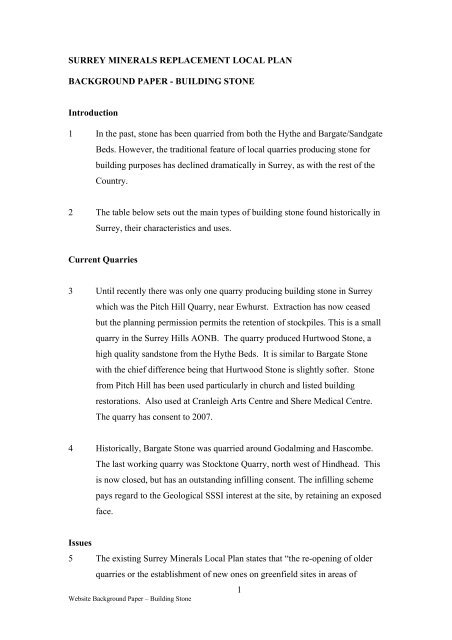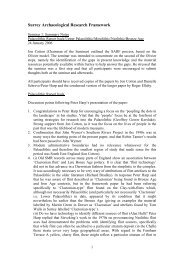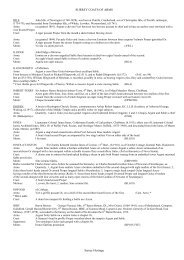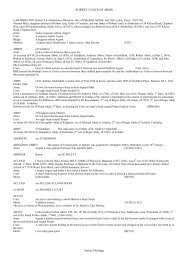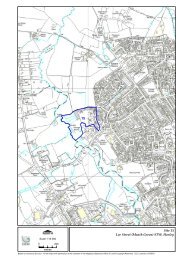Building Stone Background Paper - Surrey County Council
Building Stone Background Paper - Surrey County Council
Building Stone Background Paper - Surrey County Council
Create successful ePaper yourself
Turn your PDF publications into a flip-book with our unique Google optimized e-Paper software.
SURREY MINERALS REPLACEMENT LOCAL PLANBACKGROUND PAPER - BUILDING STONEIntroduction1 In the past, stone has been quarried from both the Hythe and Bargate/SandgateBeds. However, the traditional feature of local quarries producing stone forbuilding purposes has declined dramatically in <strong>Surrey</strong>, as with the rest of theCountry.2 The table below sets out the main types of building stone found historically in<strong>Surrey</strong>, their characteristics and uses.Current Quarries3 Until recently there was only one quarry producing building stone in <strong>Surrey</strong>which was the Pitch Hill Quarry, near Ewhurst. Extraction has now ceasedbut the planning permission permits the retention of stockpiles. This is a smallquarry in the <strong>Surrey</strong> Hills AONB. The quarry produced Hurtwood <strong>Stone</strong>, ahigh quality sandstone from the Hythe Beds. It is similar to Bargate <strong>Stone</strong>with the chief difference being that Hurtwood <strong>Stone</strong> is slightly softer. <strong>Stone</strong>from Pitch Hill has been used particularly in church and listed buildingrestorations. Also used at Cranleigh Arts Centre and Shere Medical Centre.The quarry has consent to 2007.4 Historically, Bargate <strong>Stone</strong> was quarried around Godalming and Hascombe.The last working quarry was Stocktone Quarry, north west of Hindhead. Thisis now closed, but has an outstanding infilling consent. The infilling schemepays regard to the Geological SSSI interest at the site, by retaining an exposedface.Issues5 The existing <strong>Surrey</strong> Minerals Local Plan states that “the re-opening of olderquarries or the establishment of new ones on greenfield sites in areas ofWebsite <strong>Background</strong> <strong>Paper</strong> – <strong>Building</strong> <strong>Stone</strong>1
<strong>Surrey</strong> <strong>Building</strong><strong>Stone</strong>Bargate <strong>Stone</strong>(Early sources term itas ‘Burgate’speculating that relatesto Burgate House atHambledon, but this isover a mile away fromany deposit of thisstone) 2CarstoneChertCharacteristics Found UsesCoarse pebbly sands with bands or ovals of daggersof sandy limestone. Not freestone like Reigate<strong>Stone</strong> but Lower Greensand stone. Coarser thanReigate <strong>Stone</strong> in texture. Warm brown, yellow withoccasionally greenish tints. 1Calcareous sandstone lightly tinged with ironoxide. Hard intractable stone which with an effort,admits regular coursing but cannot be ashlared. 2Veins of very hard rubbly stone. <strong>Stone</strong> of coarse,pebbly or gritty consistency, strongly impregnatedwith iron oxide and therefore always some shade ofbrown from café au lait to deep chocolate. Itbecomes harder on exposure, but cannot be said toweather well, not good enough quality to invite fineworkmanship. 2Very resistant to the weather. 3Allied to flint in character but distinguishable fromit. This is a kind of silica which occurs in noduleform, or sometimes in narrow beds of its own.Chert, although may be black is more frequentlybrownish. It does fracture differently from flint. 2Lower Sandgate Beds of the LowerGreensand in the western end of theWeald. From the Hythe Beds. 1Formerly quarried in theGuildford/Godalmingneighbourhood. Variants occur afew miles south and west ofHaslemere. 2Lower Greensand (Folkestone Beds)and occasionally in Hampshire andIsle of Wight. Hardly ever heard ofsouth of the Thames, but isfrequently applied to the Greensandsites used for building further northin Bedfordshire, Cambridgeshire,especially Norfolk. 2In many other rocks besides chalk,including Upper and LowerGreensand, Portland Beds,calciferous limestone.Lower Greensand along the northernfringes of the Weald. 2Rubblestone (unsquared, undressedstone not laid in regular courses) 2Long history of building use, eg intwelfth century main stone for GuildfordCastle. Other examples: Charterhouse;Munstead Wood; Tigbourne Court. 3Can only be employed as coarse randomrubble. St Martha’s Church. Used inlocal building practice of galleting,insertion of tiny pieces into the mortarcourses, which looks like little necklacesstrung around each block of masonry eg.Tigbourne Court. 31 S W Wooldridge & F Goldring – The Weald. New Naturalist Series No.26. 19662 A Clifton Taylor – The Pattern of English <strong>Building</strong>. 19803 Nairn & N Pevsner – The <strong>Building</strong>s of England – <strong>Surrey</strong>. 1971
<strong>Surrey</strong> <strong>Building</strong><strong>Stone</strong>PuddingstoneCharacteristics Found UsesLargely consists of flinty pebbles and small lumpsof sandstone, united into a very inedible lookingdark-brown pudding cement of iron oxide andnodules of siliceous material, sometimes very hard,but often so crumbly that pieces can be dislodgedby the fingers . 2Found in the pebble beds of theLondon Basin and or the gravelyregion of NW <strong>Surrey</strong> and theadjacent corner of Berkshire. Onlythe Bagshot Beds with theiroccasional bands of pebbles haveyielded useable stone. 2<strong>Building</strong> eg. Chobham Church (nottower). 2PalundinaLimestoneHorsham SlatesBands of limestone made of the freshwater snaillikePaludina. 1Would take a polish, therefore called marble.Geologically belongs to the same group as muchbetter known Bethersden marble of Kent andPetworth marble of Sussex. Its value was purelyinternal. 3Most important of 3 or 4 distinct sand/sandstonebeds. Horsham stone lowest of the succession. 1Slates turn dark brown after prolonged exposure. 3Weald ClayHistorically quarried at Charlwood,Outwood and Ewhurst. 2Much in evidence in the older churcheson the southern fringe of <strong>Surrey</strong> . 2Comes from beds of hard fissile Much used for roofing. 2sandstone in the Weald Clay. Thesegreat slates, although known underthe general name of Horsham, wereonce obtained from many otherplaces on the Weald Clay. 2Slates used for floors, field wall andsometimes chimney caps, as well asroofs. <strong>Surrey</strong> up to the line of the NorthDowns eg. Brewer Street Farmhouseroof. 31 S W Wooldridge & F Goldring – The Weald. New Naturalist Series No.26. 19662 A Clifton Taylor – The Pattern of English <strong>Building</strong>. 19803 Nairn & N Pevsner – The <strong>Building</strong>s of England – <strong>Surrey</strong>. 1971
<strong>Surrey</strong> <strong>Building</strong><strong>Stone</strong>Reigate <strong>Stone</strong>(often calledFirestone andknown asMalmstone in theFarnham area) 3Characteristics Found UsesComparatively soft, particularly when first dug out.Invaluable for internal work but externally by nomeans as good. It will not endure a smokyatmosphere. In the country when it has not decayedit can be attractive, for this is a light-toned stone: asandstone so calcareous that it could with almostequal accuracy be described as a sandy limestone. 3Upper Greensand formation. Thequarries and mines (for much of thisstone was mined) were not only atReigate, they were at Gatton,Merstham, and all along the narrowbelt at the foot of the North Downspast Bletchingley to Godstone, alsoin the Farnham area. 3In great demand in the Middle Ages andnot only in <strong>Surrey</strong>. London Bridge,church of St Mary Overy (nowSouthwark Cathedral), the Palace andthe present Abbey of Westminster, andWindsor, Eton, at Hampton Court andthe Palace of Nonsuch. Lends itself toboth ashlar finish and to mouldings andcarvings, this proved invaluable forinternal works of all kinds. 33Nairn & N Pevsner – The <strong>Building</strong>s of England – <strong>Surrey</strong>. 19714 Association for Industrial Archaeology – A Guide to the Industrial Archaeology of <strong>Surrey</strong>. 19905 F Gosling – The Geology of the Country Around Reigate. Proceedings of the Geologists’ Association. Vol 40. 1929


